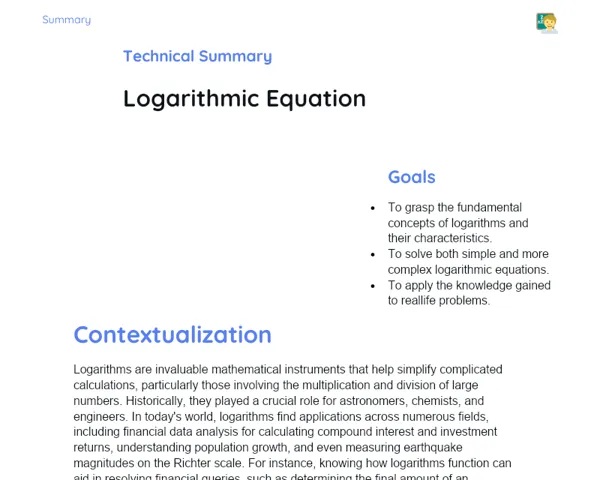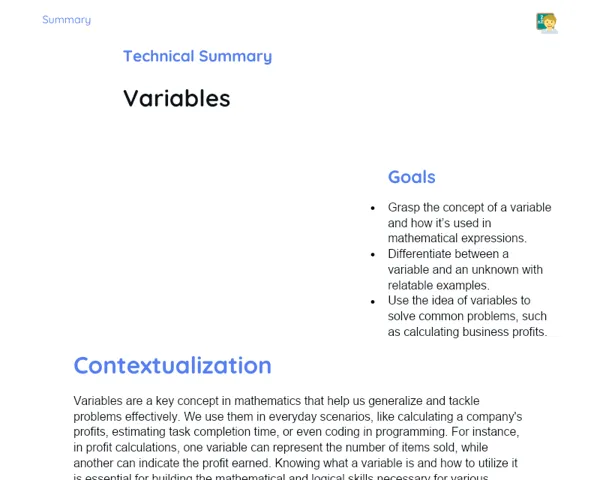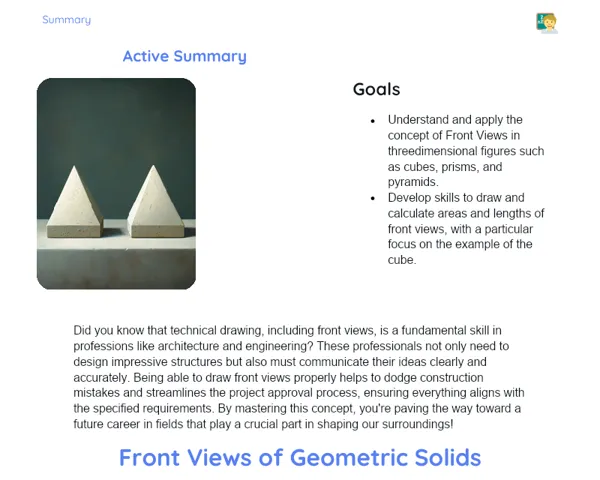Objectives
1. 📏 Master how to calculate the area of trapezoids using the specific formula.
2. 🌍 Use the knowledge gained to tackle real-world problems involving area calculations in scenarios such as land development or arranging interior spaces.
3. 🧠 Develop logical reasoning and critical thinking skills when addressing complex math challenges.
Contextualization
Did you know that the idea of a trapezoid and figuring out its area has roots that extend well beyond the classroom? Trapezoids have been instrumental in urban planning and architecture since ancient times. For instance, many ancient Egyptian fields along the Nile were designed in trapezoidal shapes to enhance irrigation efficiency. Even today, architects and urban planners harness these principles to design everything from parks to housing estates, demonstrating how this geometric knowledge is not only vital but incredibly relevant.
Important Topics
Area Formula of the Trapezoid
The formula for calculating the area of a trapezoid is A = ((B + b) * h) / 2, where 'B' represents the longer base, 'b' signifies the shorter base, and 'h' is the height of the trapezoid. This formula is essential for determining the space within a trapezoid, which is crucial across various practical applications like architecture, civil engineering, and urban planning.
-
Longer Base and Shorter Base: These are the parallel sides of the trapezoid. The difference in length between these bases gives the trapezoid its unique shape.
-
Height: This is the perpendicular distance between the two bases and is vital for accurately calculating the area. The area formula can't be applied without knowing the height.
-
Application of the Formula: Understanding how each component (B, b, h) affects the result is key in resolving real-world problems related to area calculations.
Practical Application Scenarios
Grasping how to apply trapezoid area calculations in real-life contexts is fundamental to linking mathematical theory with practical use. For instance, determining areas for interior design, where furniture must fit into trapezoidal spaces, or in urban planning, where trapezoidal plots must be optimally utilized for construction or landscaping.
-
Interior Design: Applying the trapezoid area in spaces with non-parallel walls ensures better space usage.
-
Urban Planning: Area calculations are critical in urban development to maximize land use, particularly with oddly shaped lots like trapezoids.
-
Engineering and Architecture: In construction projects, precise area calculations are essential for materials and structural arrangement.
Challenges and Solutions
While working with trapezoids, both students and professionals might encounter challenges such as inaccurate measurements of the bases or height, leading to area calculation errors. The solution lies in a solid grasp of geometric concepts and consistent practice with real problems to enhance precision and analytical abilities.
-
Precise Measurement: The significance of accurate measurements of the bases and height cannot be understated, as miscalculations can affect entire projects.
-
Practice with Real Problems: Engaging with practical exercises that mirror real cases fosters a better understanding of applications and the importance of detail in the formula.
-
Use of Technology: Digital tools and geometry apps can aid in visualizing and calculating areas, making the process more accessible and precise.
Key Terms
-
Trapezoid: A polygon with a pair of parallel sides known as bases.
-
Area: The measure of space within a two-dimensional boundary, expressed in square units.
-
Longer Base (B) and Shorter Base (b): The parallel sides of the trapezoid, typically with the Longer Base being longer than the Shorter Base.
-
Height (h): The perpendicular distance between the bases of the trapezoid, essential for area calculation.
For Reflection
-
How does the difference in length between the bases (B and b) impact the total area of the trapezoid?
-
Why is it crucial for professionals, such as architects and urban planners, to understand and apply trapezoid area calculations?
-
In what ways can studying geometry, particularly polygons like the trapezoid, enhance problem-solving skills?
Important Conclusions
-
Today, we delved into the trapezoid area formula, learning not only how to compute it but also how to apply this knowledge in real settings like land use planning and interior design.
-
We acknowledged the importance of accurately measuring the bases and height, and how each factor influences area calculation, essential skills for various professionals such as architects and urban planners.
-
We discussed how mathematics, particularly geometry, is intertwined with our everyday lives, proving that studying figures like the trapezoid is crucial for solving practical and complex dilemmas.
To Exercise Knowledge
To put into practice what we've covered, try this: Sketch different trapezoids on a piece of paper, calculate their areas, and compare your results. Utilize design software to create a trapezoidal room layout and find out how many square metres of carpeting you would need. Research notable structures that feature trapezoidal shapes and present how geometry informs their design.
Challenge
Designer Challenge: Assume the role of an architect tasked with designing a library with a reading area in a trapezoidal shape. Draw the layout and calculate the area required for shelves, tables, and seating, considering various trapezoidal dimensions. Share your project with the class or email it to me!
Study Tips
-
Review the trapezoid area formula regularly so it becomes second nature. Test it in different scenarios to see how it varies with different measurements.
-
Use dynamic geometry applications to visualize trapezoids and other shapes, helping you to better understand properties and relationships between measurements.
-
Form study groups to tackle geometry problems together and share alternative solving techniques. Collaboration can offer new insights and enhance learning.



